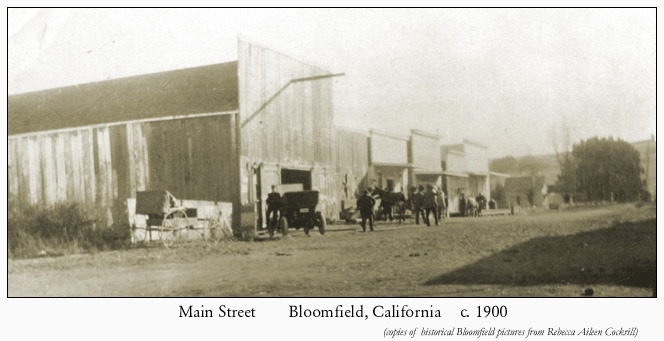

|
Bloomfield was said to be the first "white" settlement in Sonoma County. Founded within the Analy Township, it was the county's second largest town in the late 1850's (with the city of Sonoma holding first place). The Cockrill family played a big role in the 19th century founding of the town, and one of the original Bloomfield streets, Washington Street, was renamed Cockrill Street in the 20th century. However, how the town got its name, remains something of a controversy. From "Kentuckians Who Went That A Way," by Herbert J. Boothroyd, Kentucky Ancestors, Volume 30-2, 1994, pp. 82-83: |
|
Cockrills were organizers of the 30-wagon train, with 125 people... which arrived in Sonoma County, California, on 15 October 1853. There Larkin [Cockrill] built the second house in the settlement he named Bloomfield (after an early home in Kentucky); he farmed and was elected associate judge.
|
|
I asked Mr. Boothroyd his source for the story that Larkin had named the town and he responded with: |
|
...don't believe I was the source for Larkin naming Bloomfield for a Ky home; think it was in a local Calif. history. I was puzzled by the statement as Bloomfield KY is in Nelson county and I'm unaware of any of Anderson Cockrill's family going there. Larkin is in Allen Co. 1830 census. If he ever went to Nelson Co, seems doubtful it would have been long enough to be attached to the name. there is a Bloomfield in extreme southeast Missouri, but again, am unaware of any of family being in that section.
|
|
Larkin Cockrill does appear in Allen Co tax lists starting 1823 with no acreage, so apparently taxed as resident; same for 1824, 25, 26, 27, 28, 29. 1830 missing as are 32, 34, 39 and 40. Don't see Larkin on 1831 and 33, but again without property 1835, 36, 37, 38. Anderson is there all those years with property; neither on 1841 or later. This suggests that 1838, not 1835, was the date on the letter on their move to Missouri. Again, if Larkin lived in Nelson Co early 1830's, still seems too little to be sentimentally attached there, but who knows?
|
|
It appears however, that according to Cockrill Family tradition, Bloomfield was adamantly believed to have been named by Larkin Cockrill. From William Aaron Cockrill's autobiography (supplied by Rebecca Aileen Cockrill): |
|
My father was Bruce Travis Cockrill, youngest son of Larkin Davenport Cockrill and Didamia Cockrill, his wife, maiden name of Stamps, born in Bloomfield, Nelson County, Kentucky... The family crossed the plains by ox team and covered wagon in 1853 and located in Bloomfield, Sonoma County, California; Bloomfield is located in Big Valley; the first home was built there by the Cockrill family; Another family by the name of Woodson, who also came from Bloomfield, Kentucky, was the first family to locate in Big Valley, but two miles from where the town was later surveyed and promoted. The Woodson family and the Cockrill family got together and named the town that was later built, Bloomfield, after their old native town, in spite of any stories that have been told as to its meaning.
|
|
It has not been documented that
Didamia Stamps was born in Bloomfield,
Nelson County, Kentucky. There is no mention in A Sketch of the Life of
Rebecca Hildreth Nutting Woodson of her or her family ever living in
Bloomfield, Kentucky either. According to this
account
however, it was her husband, George Woodson, who had named the postoffice
Bloomfield. |
|
From Dirt Roads and Dusty Tales: A Bicentennial History of Bloomfield, Sonoma County, California, by Hannah M. Clayborn (Santa Rosa, Cleone Pub: 1976): |
|
Judge L. D. Cockrill figures prominently in some versions of the christening of the town. One account of the naming of Bloomfield, mentioned previously, states that the town was originally known as `Blumefield" for F. G. Blume, but W. A. Cockrill claims that his grandfather once lived in Nelson County, Kentucky [Oakland Tribune, 4 December, 1960]. Nearby was the little town of Bloomfield. Another source states that L. D. actually lived in Bloomfield, Kentucky [Wild Oates of Eden, Jeanne Miller]. Yet another says that the Judge named the town after Bloomfield, Missouri ["The History of Bloomfield, Calif." by Linda Albertoni, unpublished, Sonoma State University, 1972]. For some reason the Judge had the name "Bloomfield" on his mind when he participated in that fateful town meeting on July 12, 1856, or so the story goes. At this meeting it is know that the streets of the town were laid out on a north to south basis, with Jared and Cushing Hoag owning the western half and Isaac Kuffel the eastern portion. The Bloomfield post office was established at the same meeting, with the honor of postmaster going to Horace Lamb. In her memoirs pioneer Rebecca Woodson remembered that the original purpose of that meeting was to sign a petition asking for a post office. The naming of the town came up as the next logical item of business. She believed it was her husband, George Woodson who suggested "Bloomfield" in honor of the original grant owner Dr. Blume... Another account of the naming of Bloomfield was told by Russell Smith [Santa Rosa Press Democrat, 17 April 1949]... Russell insisted that some very old deeds to his ranch showed that the portion of land extending into the present town site had the name "Bloomingdale" written on it. The deed is said to predate 1856 and the founding town meeting. According to Smith, it was called this because of the many and varied wild flowers that rise up in the spring. Certainly it is still true that Bloomfield has an abundance of wild flowers each year. Or could Smith have seen the words "Blumedale Company" on his deed, the name of Dr. F. G. Blume's sawmill...
|
|
|
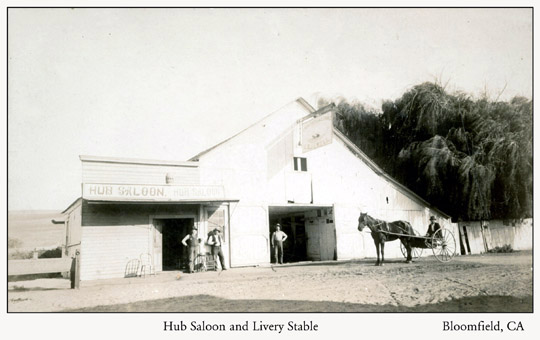
|
From the Historical and Descriptive Sketch of Sonoma County, California, by Robert A Thompson, Editor of The Sonoma Democrat, (L. H. Everts & Co., Philadelphia: 1877), p. 103: |
|
BLOOMFIELD. This town is situated at the head of Big Valley, or the valley of the Estero Americano. It was first settled by Judge Cockrill and Bill Zilhardt. A man named Lamb started the first store. Among the earliest settlers in the neighborhood were W. P. Hinshaw, W. H. White, L. D. Cockrill, Henry Hail, John Linchaugh, Alonzo Walker, the late John Peters, Hugh Stockton, Wm. Jones, Hon. E. C. Hinshaw, and O. P. Hoag. There is a post, express and telegraph office in the town; two stores, one hotel, three churches, (Presbyterian, Methodist, and Advent), one Masonic hall, and a lodge of Odd Fellows; one harness and three blacksmith shops, one cooper shop, and a flouring mill. The population is about two hundred and fifty. There is an excellent public school with over a hundred scholars. This place is surrounded by as rich a farming and dairy county as there is in the State of California.
|
|
|
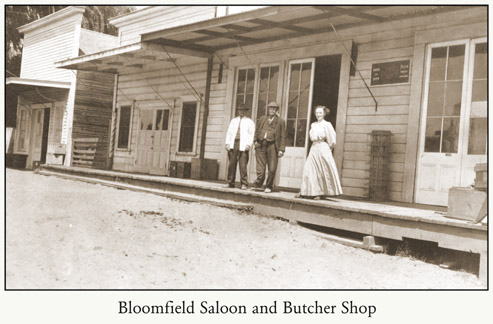 |
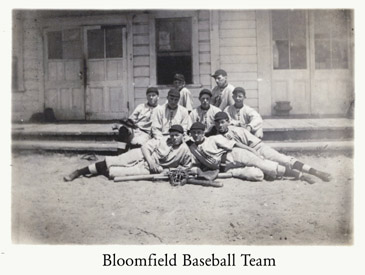 |
|
In its prime, Bloomfield was known as the "potato capital" of California. It was said that "The Big Valley Spud" was even better than those from Idaho, and was "the best spud in the U.S.A." From Santa Rosa, a nineteenth century town, by Gaye LeBaron, Dee Blackman, Joann Mitchell, and Harvey Hanson (Historia, Ltd., Santa Rosa: c. 1985), p. 56: |
|
Potatoes were the first cash crop in [Sonoma] county; thrust hastily into the scarcely plowed ground. Shipped downstream from Petaluma to the bay, they turned that rude hunting camp into a flourishing port and made a big town, for a short time, of Bloomfield, the potato capital of early California. The early censuses show that Sonoma County grew more potatoes than any county in the state in the 1850s. Credit for planting the first potatoes went to a pair of squatters on the Bodega Rancho, John Keyes and his partner, last name of Noble. They planted on the headland, known then as Bodega Point, in 1850. To get that first crop to market, Keyes bought a 15-ton schooner called The Spray. He continued to haul potatoes from Bodega Bay to San Francisco in his small ship until 1857. He hauled passengers, too -- $8 to San Francisco, $15 to return. James Watson, born in Ireland of Scottish ancestry, generally was credited with the development of the potato which became known in San Francisco markets as the "Bodega Red." Watson had come to Sonoma County in 1849 to run Bodega grant-holder Stephen Smith's new tannery. Growing his first crop on rented land, he "struck a potato bonanza" in 1850, according to coast area historian Honoria Tuomey, when he exchanged 1,000 sacks of Bodega Reds for 1,000 acreas of Bodega Land. William McReynolds, a Green Valley potato rancher, built the first potato warehouses: one at Bodega Bay in 1851 and another, with his partner James Hudspeth, in Petaluma. The Fowler brothers, Stephen and James, also coast settlers, planted the first garden vegetables commercially. This was the logical first-year crop, after potatoes, for farmers in the sunnier inland valleys, including Santa Rosa. Seasoning the basic meat-and-potato stew must have been a concern, for the settlers grew acres and acres of onions...
|
|
|
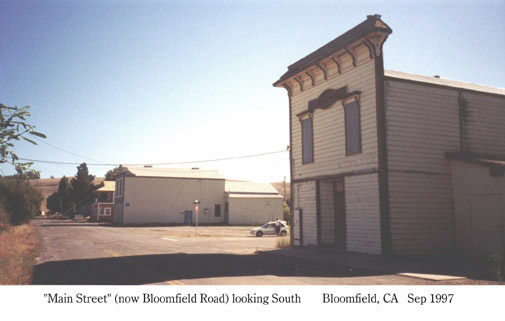
|
From a History of Sonoma County, by J. P. Munro-Fraser (San Francisco: Alley, Bowen & Co., 1880), pp. 173 -175: |
|
BLOOMFIELD.Bloomfield is situated at the head of Big valley, or the valley of the Estero Americano on the Rancho Canada de Pogolome, and was named in honor of the owner that grant, F. G. Blume. The first house was built in the town by Wm. Zellhardt, in 1853. He soon afterward built a blacksmith shop. L. D. Cockrill built the next house here, also 1853. In 1854 a man by the name of Horace Lamb opened a store, using a part of Mr. Cockrill's house for the purpose. During the year, however, he erected a building of his own and occupied it. Two years later, July 12, 1856, a postoffice was established at this point, with Horace Lamb as postmaster. During this year also the town was laid out, C. and J. Hoag owning the western part of the site and Isaac Kuffel the easter portion. From this time on the town flourished as well as could be expected under the circumstances. It was an inland trading point, with no direct communication with San Francisco for a number of years. Stores, hotels, blacksmith shops, churches, schools, etc., were established. The cemetery, which is situated to the westward of the town, and on an eminence commanding a beautiful view of the town and adjacent country, was laid out in 1860. The first person buried in it was Mrs. Stephen L. Fowler, daughter of L. D. Cockrill. The business interests of the town are represented as follows: One flour mill, two hotels, three blacksmith shops, two wagon shops, one paint shop, two general stores, one saloon, one meat market, one livery stable, one harness shop, one shoe shop, one millinery store, one tin shop, one lawyer, and no doctor. The official directory is as present as follows: Justice of the Peace, L. D. Cockrill; Notary Public, C. C. Farnsworth, who is also Postmaster; Telegraph and Wells, Fargo & Co.'s mails. A stage passes each way daily, connecting with the North Pacific Railroad at Petaluma, and with the North Pacific Coast Railroad at Valley Ford. The population of the town is about two hundred and fifty, and is situated in the heart of as fine and productive a section of farming land as there is in California. The town will never be much larger than it is now, however, as communication with the city is too remote. A full history of the lodges, churches, schools, and industries of the town will be given below, to which we refer the reader. Bloomfield Flour Mill. -- This mill is at present owned by W. C. Purcival, who came into possession of it in May, 1873. The gentleman who erected it had the misfortune to meet with an accident during its construction by which he lost his life. The building is eighty by one hundred feet, and two stories high. It has three run of burrs, and a capacity of thirty-five barrels of flour and twenty-five tons of barley a day. It is run with steam, and new boilers and machinery have lately been put in, so that it is now a first class mill in every respect. The flour made here is very good indeed, commanding a ready sale at the best market prices. The mill is run about nine months a year, and affords a ready market for all the grain grown in that section. Valley Ford Lodge, I. O. O. F. -- Valley Ford Lodge No. 191, I. O. O. F., was organized September 7, 1869, at Valley Ford; hence the name. Its charter members where William Hamilton, A. S. Perrine, A. C. Wood, S. N. Hudson, Edward Hare, and William Withrow. The first officers were: -- William Hamilton, N. G.; William Withrow, V. G.; S. N. Hudson, Secretary, and Edward Hare, Treasurer. The following gentlemen have had the honor of being N. Gs.: William Hamilton, William Withrow, Edward Hare, T. M. Johnson, J. T. Mitchell, John Appleton, O. H. Hoag, W. N. Wakefield, B. F. Hickleman, Bruce T. Cockrill, O. M. LeFebvre, Peter Eastman, G. W. Knapp, H. C. Crowder, and C. H. Knapp. The Lodge was moved to Bloomfield March 9, 1875. Its present membership in fifty-six, and it is in a most flourishing condition. During the past year it has erected a building at a cost of three thousand dollars, the lower story of which is used for mercantile purposes, while in the upper one there is an elegantly furnished lodge-room. Bloomfield Encampment. -- Bloomfield Encampment No. 61, I. O. O. F., was organized Jan. 10, 1877, with the following charter members: H. C. Crowder, B. F. Hickleman, Bruce T. Cockrill, S. H. Manzy, Valentine Wilson, O. M. LeFebvre, A.H. Knapp, G. W. Knapp and Chas. Hoag. The following gentlemen have held the position of C. P.: H. C. Crowder, Bruce T. Cockrill, G. W. Knapp, Valentine Wilson and A. Little. The present membership is twenty-four. |
|
|
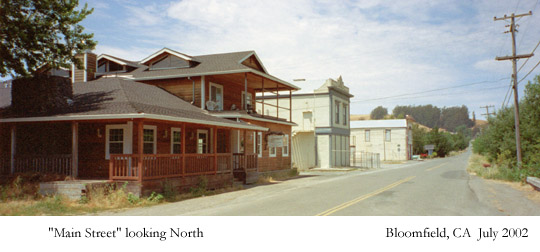
|
|
|
Vitruvious Lodge, F. and A. M. -- Vitruvious Lodge No. 145, F. and A. M. was instituted under dispensation May 31, 1860. The charter members were as follows: T. G. Cockrill, R. Dickens, J. M. Hinman, S. Honisgberger, I. Kuffel, D. Markel, J. R. Ross, J. W. Zuver. The officers U. D. were J. M. Hinman, W. M.; D. Markel, S. W.; I. Kuffel, J. W.; and T. G. Cockrill, Sec'y. The charter was granted June 7, 1861, and the first officers under charter were: D. Markel, W. M.; I. Kuffel, S. W.; C. R. Arthur, J. W.; R. Dickens, Treas, and T. G. Cockrill, Sec'y. The following named gentlemen have filled the W. M's. chair: J. M. Hinman, (U. D.); D. Markel, C. R. Arthur, T. G. Cockrill, N. R. Shaw, W. G. Lee, C. White, J. S. Oliver, W. C. Purcival, and W. W. White. The present membership is fifty, and the lodge is in a very flourishing condition. They have a nicely furnished lodge-room, and the stranger entering their cosily furnished hall cannot but exclaim, "Behold how good and how pleasant it is for brethren to dwell together." Bloomfield Lodge, I. O. G. T. -- Bloomfield Lodge No. 256, I. O. G. T., was organized August 19, 1878. Following is the list of charter members: W. H. Haskins, James Hoag, C. C. Farnsworth, D. L. Knapp, Ada Haskins, Louis McReynolds, Albert Crose, Horace Lamb, Edward McReynolds, Lizzie Gregory, Ida M. Haskins, Chas. McReynolds, Carrol Jones, John McAllister, Emil Baker, A. E. Kellogg, W. W. Parks, Sarah Stone, Ernestine Walker, Anna Crose, E. M. Sharon, Maggie Sharon, Clara Farnsworth, Mary Jones, Alice Pharis, Clarence Wilson, Frank Lamb, Thomas Gregory, E. L. McReynolds. The following have filled the position of W. C. T: W. H. Haskins, A. E. Kellogg, Thomas Gregory, P. C. Smith and William Talbot. The present membership is forty-one, and the Lodge is in a very flourishing condition. Bloomfield School. -- The first school in this section was taught in what was known as the Big Valley school district. The school-house was situated about one mile east of the present site of Bloomfield. The first school ever taught in the town was under the charge of James Harlow, and was in the M. E. church building. The present large and commodious building was erected in 1866. It is two-stories high, and is amply large for all the requirements of the town. There are two teachers employed, and, of course, two grades in the school. There is a good library of over two hundred volumes attached to the school. Among those who have taught there in days gone by may be mentioned: A. H. Hall, James Radcliffe, T. H. Hopkins, A. H. Pratt, J. H. Wilmer, T. C. Powers, E. D. Roberts, and others. Churches. -- We are sorry to say that we were able to gather but little historical information concerning the churches in this place. In the first place, some years ago the records of the M. E. church were stolen, and the Advent church has moved to Stony Point, while the headquarters of the Presbyterian church are at Valley Ford. However, we will say that all these organizations have very comfortable churches at this place, and that they are all well supplied with services. A gentleman known as Father Walker organized the M. E. church at this place in 1857. He was the pioneer minister of the county.
|
|
|
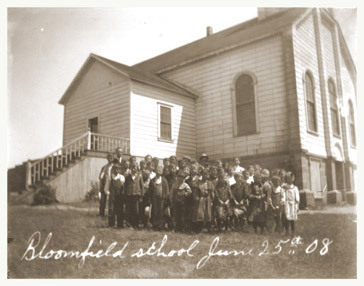 |
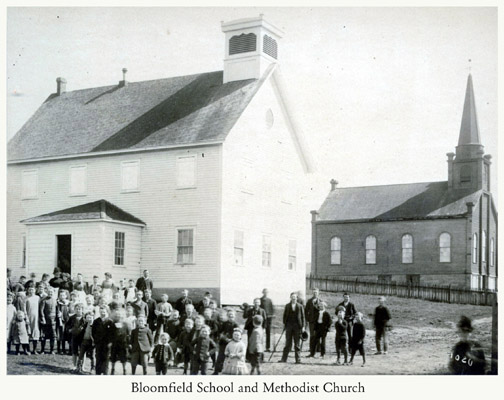 |
|
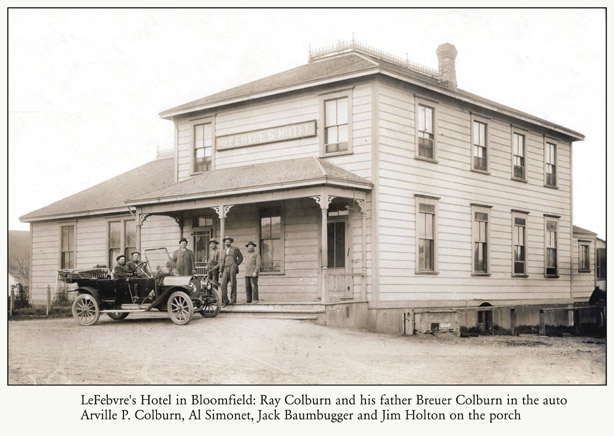 |
||
|
From the Illustrated Atlas of Sonoma County California: Compiled and Published from Personal Examinations, Official Records and Actual Surveys, (Published by Reynolds & Proctor, Santa Rosa, Cal.: 1897), p. 50: |
|
BLOOMFIELD Bloomfield is a small but important town in Analy township, seventeen miles southwest of Santa Rosa. Valley Ford is the nearest railway point and the town has regular daily stage communication with Petaluma. It is the center of a rich farming district and the country roundabout is thickly settled by prosperous tillers of the soil.
|
|
|
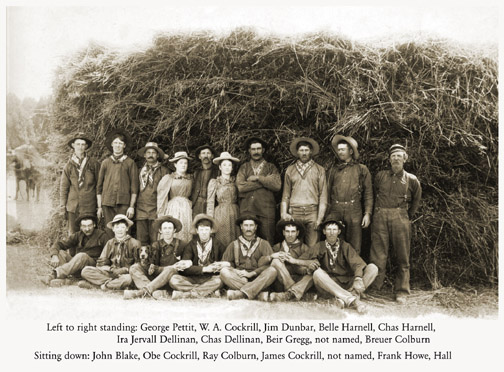
|
From "Local History and Tales from Bloomfield, Sonoma County, California", essay by Mary L. Murphy ("Special Studies Eng. 495, Spring and Fall, 1974," Petaluma History Room 979.418 Murphy), p. 4: |
|
...Known as an inland trading point and a stopping point on the stage coach route between Petaluma and Gualala, Bloomfield became a center for horse breeding and trading, even at one time having a racetrack. Although isolated from the roads and railways, Bloomfield had communication with the "outside world by the North Pacific Coast telegraph, also by United States and Wells, Fargo & Co.'s mails." The community, as were many in those days, was virtually self-sufficient. The business interests in Bloomfield provided for most of the residents needs, and a doctor was eventually obtained, Dr. Cockerill [sic]. The thrashing machine, run by Mr. Colburn, and the steam-run mill, purchased by Mr. Purcival in 1873, provided for the processing of wheat, the major agricultural interest of the area. Potato farming was also an important industry. At one time, over three hundred Chinese laborers worked in the fields around Bloomfield, living in huts in "Chinacamp," near what was the main street. Even some of the official street maps of Bloomfield record a "Pigtail Alley." As the community's needs increased, they also rose to meet them. The cemetery was laid out in 1860, the first burial being the daughter of L. D. Cockerill in the same year. The history of Bloomfield's churches is somewhat vague, due to the theft of the records of the Methodist-Episcopal church, established by Father Walker, pioneer minister of Sonoma County in 1857. There were as many as three churches at one time in Bloomfield, all now moved to near-by towns, as well as four brotherhood lodges. The Bloomfield School, was first established in the Big Valley School District, was taught under the charge of James Harlow, the present building (as of 1880) having been erected in 1866. There were two teachers, a library of more than two hundred volumes, and "of course, two grades in the school." The "Bloomfield Bell" that hung in the school's bell tower, and today is in the community bell tower, was brought to Bloomfield all the way from Boston in 1860 by William Hall. It seems, however, that even the early residents of Bloomfield had some inkling of the decline of the once second largest town in Sonoma County (Sonoma was first). An 1880 publication notes that "From this time on the town flourished as well as could be expected under the circumstances... The town will never be much larger than it is now however, as communication with the city is too remote." The problem was not so much the condition of the dirt road, which became a main highway in 1927 but was not paved until the early 1930's along with the dirt roads that ran through the town, but the fact that Bloomfield was not included on the rail lines. A measure started in 1871 and 1872 by some Bloomfield assemblymen to extend the Northern Pacific Railroad to Bloomfield from Petaluma was vetoed by Governor Haight. In 1876, the neart [?] railroad, a narrow guage electric line, went by way of Two Rock, Roblar and Valley Ford, bypassing Bloomfield by about six miles.
|
|
|
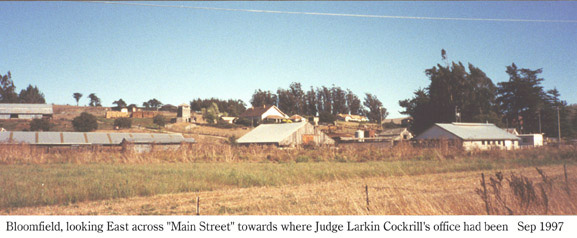
This page created on 03/11/01 15:42. Updated 08/08/04 22:38.